You’ve decided that your business needs to launch a new website. The next logical step is to figure out how much does a web design cost, find the best developer and strike a deal. It should be a straightforward process but web design pricing and finding the right studio is one of the biggest and most stressful challenges a company can face.
Once you start pricing websites online with different design studios, you’ll soon realize that it’s extremely difficult to get a straight answer for the cost of a web design project. First, studios will want to speak with you on the phone. Once you spend an hour with every studio, you’ll have a range of different estimates lined up.
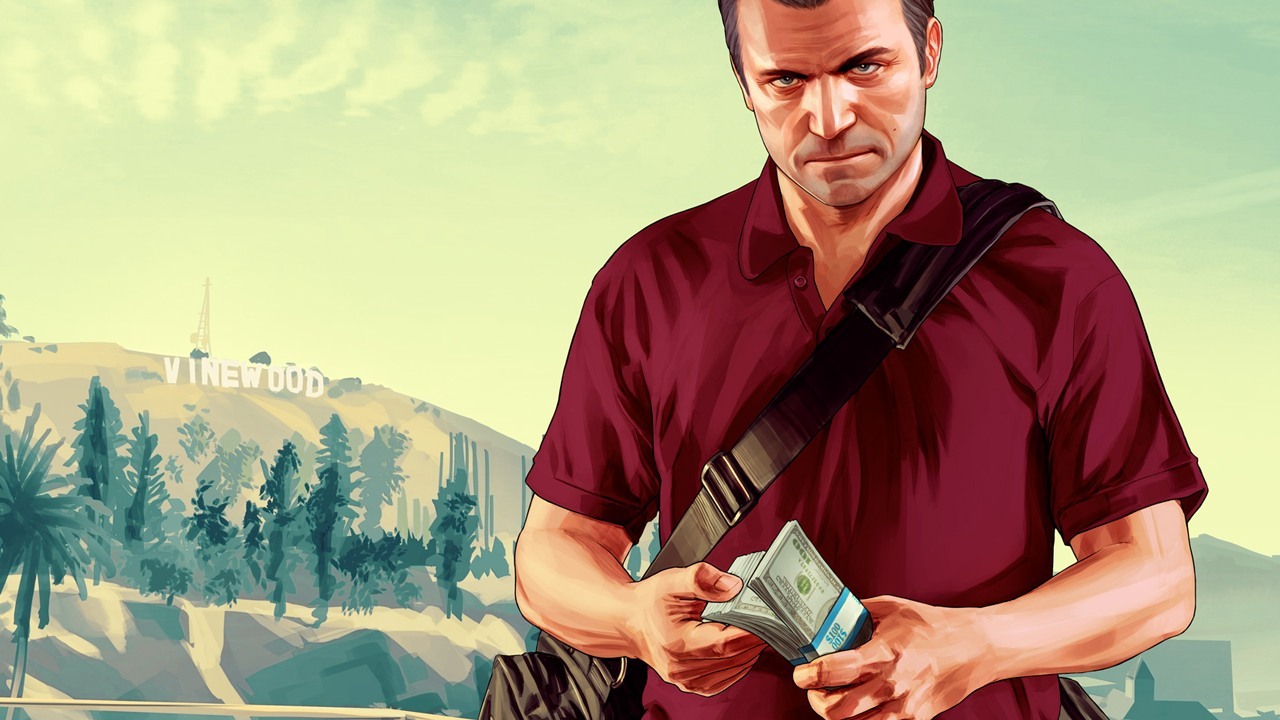
The price will vary so much that you might begin to imagine some design studios in ski masks committing online daylight robbery, while others are just too good to be true.
And if you make the mistake of posting your web design project on a freelance bidding website, then expect 60-100 spammy responses with a price tag starting from $100 for any given project.
You’ll soon realize that without the technical experience needed, trying to find reasonable web design pricing is like walking through a minefield. You’ll be faced with a range of problems that will make it difficult to build the right kind of site on a budget that works for your business:
- There is a lot of options that you didn’t even know exist
- Many design studios will say they can do everything
- You can’t filter unqualified developers
- Many studios are trying to sell additional services you don’t need
- The estimates of different companies vary, sometimes by x50 times
- You can’t tell whether the price is fair
- You can’t plan your budget
Is there a way to estimate the cost of website without having technical expertise?
Yes. But you need to get your hands dirty.
Compare it to building a house. If you want to build a house, you need to dive in and explore the available options, benefits, and drawbacks of different methods and materials, possible pitfalls, and only then can you make a well-informed decision.
The same goes for web design and development. There is no other way than setting apart a day or two and going through all the technical terms, available options, estimatesб and tricks to the trade that are available across the internet.
Getting your Hands Dirty (or How to Get a Fair Price)
To get a fair price, you need to:
- Know what exactly you want
- Evaluate the website design cost by yourself
- Get in touch with the right web design firms or individual developers
To do that, you have to educate yourself on the following topics:
- Components of web design and development (to understand the technical complexity of your project)
- Available options (hint: there are more than you think)
- Different levels of agency expertise (to understand the creative complexity of your project)
- Common pitfalls of cost estimates (in order to avoid them)
- How to compose an RFP (request for proposal)
- Web design prices around the world
- Ins and outs of outsourcing to other regions in the world (in order to get the best deal)
The good news is that I’ve put together all of the above in a single article.
For the last 7 years, I have worked in different fields of web development and headhunting. Starting as a software developer, I shifted to marketing, then sales, then project management and ended up in a strategic position. I am going to use all of my experience to help you make an informed decision before contracting a design studio for your new site.
Why Estimating the Cost for a Website is so Difficult

There are three main reasons that make pricing a website so difficult:
- Every project is unique in some way
- The scope of work may change
- Unqualified developers in the market
Let’s consider each of these factors in detail.
1. Every web project is unique in a few ways. The clients will want their website to stand out from the crowd, which means that they want to have a unique design. A design that no-one has drawn before. Uniqueness is a result of creative thinking, and this process is unpredictable by definition. It is also hard to set clear expectations for creativity and evaluate the results. That is why you have to choose a great agency, not just a good one.
2. The project requirements may change. For example, when the agency is conducting market research, it may come up with ideas that can significantly increase the website effectiveness but extend the scope of work as well.
There are three approaches for dealing with this kind of uncertainty :
A) Get a fixed-price quotation
The right and the hardest way. That means, that the agency is projecting the website, creates the website structure, wireframe prototype, composes a list of features and designs the high-level software architecture. It takes time and costs money. But as a result, you can get a fixed-price estimate and see what your project will look like before you build it. We recommend taking on this approach for most people looking to create a new website.
Consider an analogy with the real estate industry. If you come to a real estate developer and ask ‘how much would it cost to build a house of 2 floors 5 rooms each’, his answer, will be probably ‘I do not know’. Because first, you need to go to an architect and create a plan, which can be then estimated. Of course, you tell the architect what your budget is but you don't know the real price until the plan is ready.
Though, this approach requires a certain level of trust. Clients will usually require at least a rough estimate before making a deal, and tend to work with agencies that can talk numbers from the first call. So this approach is often used in combination with the approaches below or is completely amended in their favor.
B) Gather visual references and list of features, give a rough estimate
This is how most agencies work. You are just providing them with a list of pages and features you need, and some examples of websites you like. They get back to you with questions, and after a few iterations, you will receive the web design price estimate.
C) Decide upon your budget, and see what you can get
This is a way to go if you don’t know exactly what you want on the website, or you want to rely on the agency’s expertise and see what they can propose. You define your budget and ask them to design a website that matches what you are willing to pay. This is usually a good approach for clients who want to put together an animated promotional website (example).
3. A vast amount of unqualified developers. There are plenty of web design firms that aren't getting much work and are ready to get on anything for a very low price. Though there might be some rising stars among them, for the most part, there is a very good reason why they don’t have many clients: bad reputation.
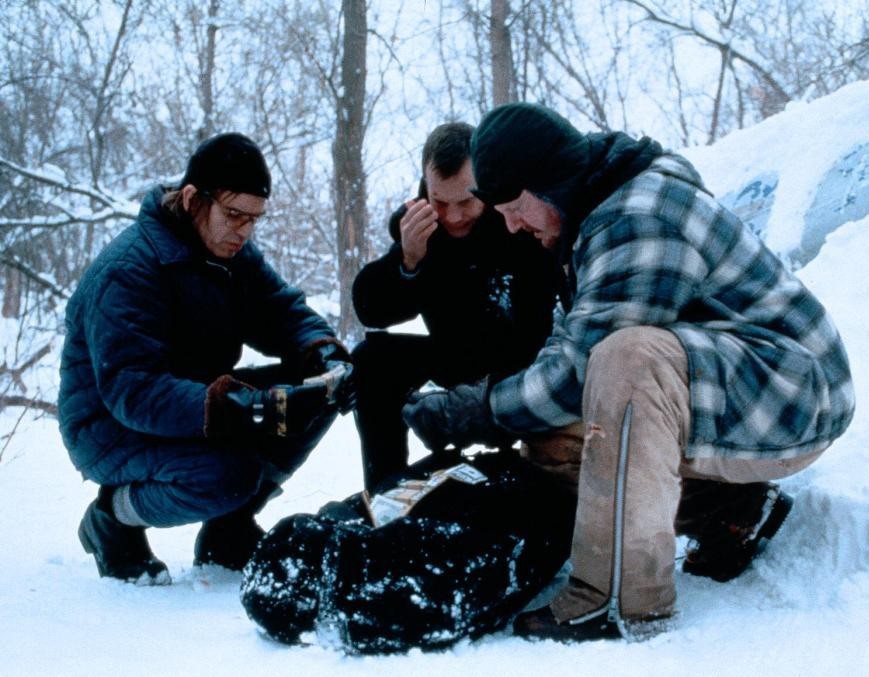
The other type of studio that is eager to go after is easy money, are the ones that send a high estimate at first and then cut the price in half when you begin to negotiate. This is a clear warning sign that the company wants to get as much money from you as possible and is not really on your side. So try to negotiate a bit and see if their estimates are well grounded, or they are just taking you for a ride.
Now, as you know what makes web design estimation hard, it's time to move on and explore its cost structure.
What Impacts the Cost of Web Design
The general rule of design estimate is:
Cost = Required Working Hours x Rate
Where the Required Working Hours depend on Technical complexity and Creative complexity, and the Rate depends on both of the above, and also on labor costs and expertise of a given team.
In other words, the cost depends on the following factors:
- Technical complexity
- Creative complexity
- Labor costs
- Brand level (level of trust) and expertise of a given team
- Size of the company (usually, the bigger the company, the bigger the rate is)
We will go through all parts of this equation.
Technical Complexity

To understand this part, you need first to familiarize yourself with the terms, main stages and methodologies of web development. I will explain them very briefly.
There are two methodologies for web development: waterfall and agile. Waterfall methodology means that you go from stage to stage and you never change your requirements. If you asked to create a website of 5 pages, you will get a website of 5 web pages; once you have accepted the website structure, no changes can be made, and so on. This is the fastest and the cheapest methodology. Though not very client-oriented.
The other way is referred to as agile. Agile means that the development team works by providing you with a finished stage of the project every week or two. You can ask them to implement new features, pages or changes to the design whenever you want. The only drawback is that this approach takes much more time a bigger budget to work, as the new changes you add often require discarding the previous work.
Usually, web design company can use a combination of these two methods, which means you have certain planning, but you can implement additional features for an additional cost.
Stages of Web Development
1. Research
Know your enemy. To make a perfect website, you have to meet your competitors face to face and analyze their strengths and weaknesses. You (or your agency) may conduct your research in two fields: functionality of their websites and promotional strategies.
By researching functional features and website structure, you will achieve two goals: you define what features you are going to copy, and what features you are going to avoid. For example, building one of the world’s best interior design websites (which, by the way, took 18 different concepts of design), we analyzed literally every significant competitor, noted their website structure and built something completely different.
By analyzing the promotional strategies of your competitors, you can see the most time and cost efficient ways of attracting customers. There’s a number of fields you can dive into: SEO, traffic sources, SMM, content marketing, CPC, and banner advertising.
There’s a number of tools for looking at promotional strategies, including: SEM Rush, SimilarWeb, Ahrefs, Google Spreadsheets, the 5 Whys technique, and powerful, irresistible, cold Stoic logic.
Another area you need to research is your customers. Do you have a clear idea of who your customers are, your main target groups, their needs, motives, factors of trust, interests, and online habits? You may use several techniques to answer these questions, like one-to-one interviews, online and offline surveys, research through social media, focus groups (but use them wisely). The results of customer research should be formalized, and I recommend using User Personas (User Personas are a kind of imaginary friends).
2. Identity Design
Establishing and understanding your businesses’ Identity is also essential. This includes a good company name, visuals, and mottos that reflect company values. Visuals usually include logotype, corporate colors, and fonts. Very rarely a web agency will be good at both web page design and corporate identity design, so ask for examples of their work in this field before you sign a contract. Your company identity is the second most important thing that will form your company’s brand (the first is the quality of your product).
3. Planning & Prototyping
Here comes the most fundamental part - the birth of the future site. The UX designer studies the research data and creates a list of informational blocks that you’ll need to show your visitors. He organizes those blocks into a Sitemap, using Informational Architecture principles. Then he develops a User Journey, which is the pathway that your visitors are most likely to take on the future website.
Once the Sitemap and User Journey are ready, he develops a wireframe prototype, that reflects the navigation, structure of pages and the copy content of your future site. Prototyping helps to reach an understanding between the development team and the customer and also helps the development team to communicate internally. Thus, saving a lot of time and money.
4. Web Design
This is where the magic happens. The web design skeleton turns into a living creature and a very beautiful one at that. As a client, you have to remember the single most important thing: web design is not an art and a designer is not an artist. The purpose of designing a website is to reach your business goals and not to be pretty, as prettiness is subjective, and business goals are objective. The designer has to structure the information in an easy, comprehensive and aesthetically pleasing way, according to a single design style and keeping in mind the user (User Personas).
The most time-consuming part is the design of the main page. The designer has to create the whole website style and a lot of elements from scratch. Clients rarely approve the design from the first draft, so it often requires making a lot of changes or even designing new concepts. Homepage design can take up to 7-10 working days. But once you’ve settled on a certain variant of the homepage, the rest should be smooth sailing.
Each page has its own complexity, which can be measured by the amount of information and blocks to show in design. Two similar pages can be designed much faster than two completely different ones, as some elements can be copied.
Modern websites usually have some type of animation, which make them way more interesting than ordinary static pages. The website designer has to come up with ideas for the animation he wants to implement, draw necessary elements, and pass that information to a Front End developer (a software engineer, who will turn images from Photoshop to web pages). Animation can increase the design time by 30-50% and multiply Front End development time.
If you want to cut the costs, consider building a website with fewer pages. You may add them at a later date.
5. Front End Development
Static images are turned into web pages. This is not an easy job, as you have to literally replicate the image you’ve got from a designer with HTML code and deal with limitations of multiple web browsers.
Does your website have any animation? This stage will take a considerable amount of time. 10-15-page website with 2-3 complex animations like TA Ventures can take up to 5 weeks of development. Be aware that the more animations you add, the more expensive the website will be.
6. Back End Development
Back End development is the implementation of interactive features, which usually involves storage or reading data from the database. The more features you have on your website, the longer this stage will take (and more expensive it will be). Here are some examples of common back-end features:
- Contact form
- Ability to like an article, social sharing
- User login
- User registration
- Search
- Blog, forum (those are whole sets of features)
Most websites do not have a lot of features (corporate sites, promo sites), but the others (like Twitter, Reddit, Amazon) are feature-heavy and can cost you a fortune (of course, if you won’t find a template solution with pre-implemented features).
If you expect a large amount of traffic (over 100K visitors per month), you probably would need to build a scalable architecture for the website, which is always a complex task.
The fewer functions you include to your website, the cheaper it will be. Consider building an MVP to test your business idea before investing a fortune into something that might not work out.
7. Adding Content
After the website is done, it should be completed with the actual content. Usually, it doesn’t take much effort. Except for e-commerce projects, which often have thousands of pages and tens of thousands of items. On such projects, content management may cost you up to 10% of the budget. On the other side, if your website has under 100 pages, the web development company usually covers the costs.
Platforms, frameworks, and CMS
Web development companies work with different Content Management Systems (CMS) and frameworks. The CMS is the platform that lets you edit the content of the website.
If your design fits into standard “header - menu - newsfeed - footer” structure and doesn’t have too many unique features (complicated Back-End), a standard CMS like Wordpress or Joomla may be a perfect fit for your project and save you money when it comes to editing content at a later date. If your design is more complex and you plan to add a lot of features, like user registration, personal profiles, and bonus system, then it requires building a custom CMS, tailored to the project’s needs. A good custom CMS has all the necessary tools to edit the content and its support will cost you the same money as a standard CMS. Take into account that if you try to add non-standard functions or create a complex design based on standard CMS (e.g. Wordpress), the cost will grow exponentially with every new change you make.
However, I would not recommend you to make the decision on which CMS to use by yourself. Inform your developer that you’d want to be able to edit the content and provide some references of how exactly you’d want to do that, and ask him which platform would he recommend. Request the access to an admin panel of some of their accomplished projects. And then decide whether you like it or not. Of course, it makes sense only if the developer is familiar both with different CMS and custom development.
Types of web projects
It’s impossible to create a precise classification for web projects, as one may often fall into two or three categories at the same time. The classification table below will help you understand the complexity of your project, so you will be more in control of the development process and make more informed decisions when choosing a web development company.
Cost of landing page development
This is the simplest type of project to evaluate and implement. A landing page usually consists of just a single page and has just one feature - contact form. Though, you might want to create something more complex.
Below, I am providing both timeline and prices estimates for every type of project. I’ve gone through all of the mentioned references with our Head of Design and our Team Lead to estimate the timeline. And for every project I gave a price estimate, using the average Eastern European rate, which is $35/h. For the United States, the rate would be different, around $150-$200/h, so you have to multiply the number of hours by the average American web design rates.
Examples:
- http://www.apple.com/mac-pro/ - est. 700h of work, $25K (as it uses complex 3D animation)
- http://divenamic.enjoy-aiia.com/ - est. 200h, $7K (video production is not included)
- http://kvadrat.com.ua/ - est. 150h, $5K (just the main page; video production is not included)
- http://conversionlab.no/ - est. 120h, $4K
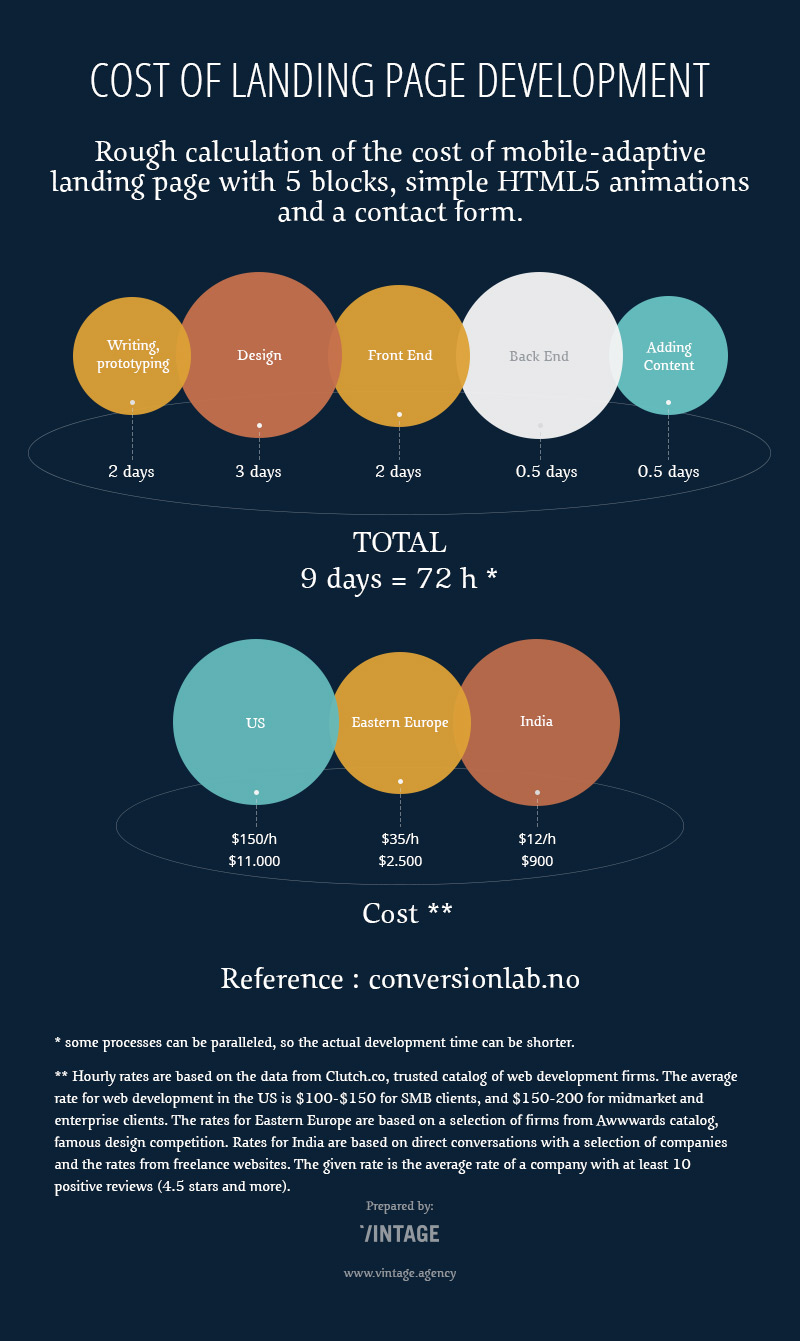
Cost of corporate website development
Every business needs a website, whether it is providing good or services. The site gives them the online space to promote their products or services, their special approach, team, and much more information. Usually, corporate websites have under 20 pages.
Examples:
- http://taventures.vc est. 700h, $25K under 15 unique pages, eye-catching interactive animations
- http://netflix.com est. 2000h, $70K >50 unique pages of simple design, personal cabinets
- http://skype.com est. 1300h, 40K(just corporate website, without the ability to make calls online) - under 30 pages of simple static design, personal cabinets
- http://mahno.com.ua/en - est. 2200h, $80K and involved creation of 18 design concepts. 20 pages of world-class design. Turned out to be one of client’s best investments.
- http://siutkin.com/en - est. 600h, $20K, under 15 pages of great design
- http://rio2016.fie.org/ - est. 1000h, $35K - under 20 pages of great design, includes real-time synchronization with the results of Olympic Games)
Many corporate websites are combined with web services (paypal.com), online stores (microsoft.com), and/or have forums, support ticketing systems, and integrated blogging platforms. That means they often fall into two categories at the same time, being both corporate websites and web services. They are hard to estimate until you create a detailed list of pages and functions you need to implement.
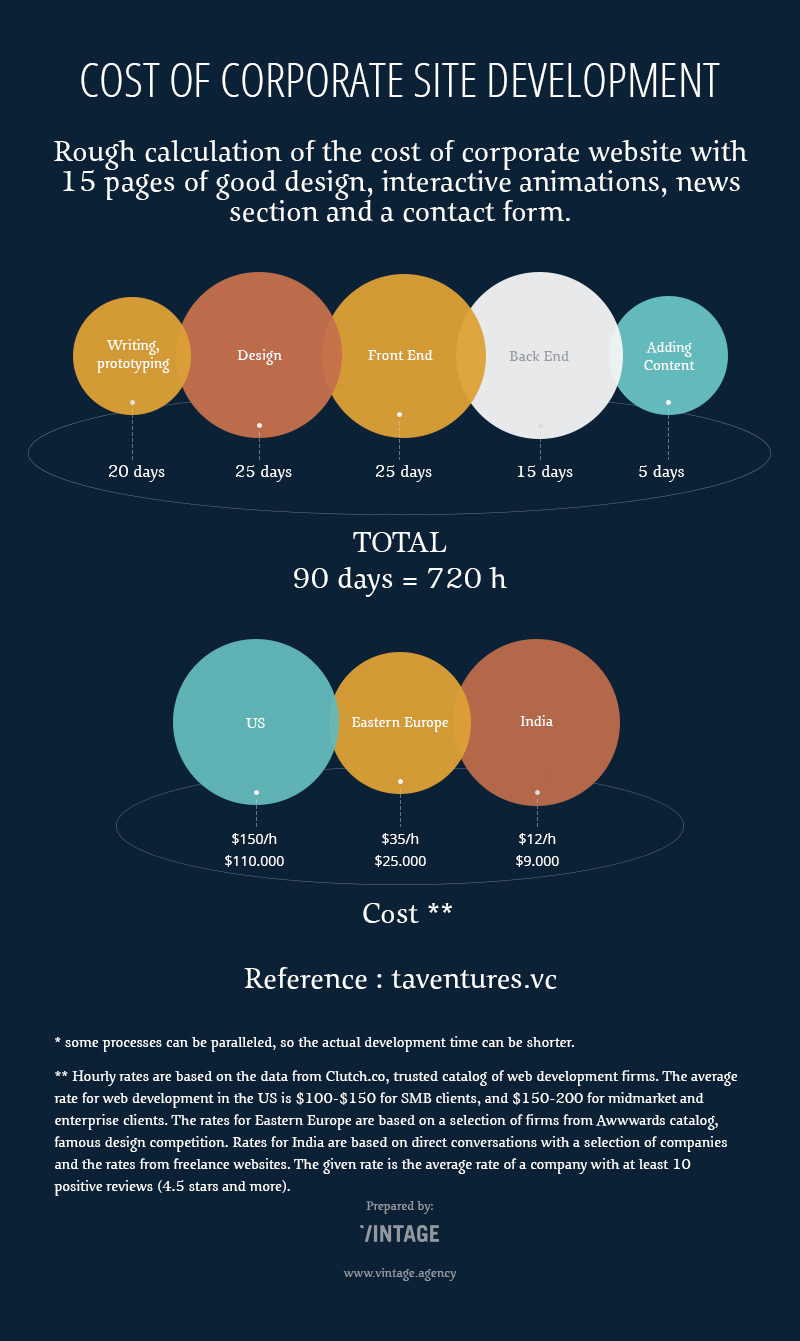
The cost of promotional website development
If you want to gain public attention to your product, evoke emotions and go viral, then you have to build a marketing-friendly website. Websites of this kind usually don’t have more than 5 pages and are focused on a single product. The difference between a promotional website and a landing page is mainly in the complexity. Promotional websites involve the development of a Creative Concept, storytelling, a lot of illustration work, and have way more complex animations. They are also less “salesy” as their aim is not to sell but to evoke emotions. You can find some of the world’s greatest promo websites here.
Prices for Creative Concept development range dramatically, from a few thousand dollars to hundreds of thousands. So I will provide you only with estimates of design and programming work. The creative work can’t be measured simply by the number of working hours.
Examples:
- http://copout.me/en - est. 600h, $20K + the cost of concept
- http://gettyendless.com - est. 600h, $20K + the cost of concept
- http://becherovka.com - est. 1000h, $35K + the cost of concept
- http://124spiderroads.fiat.it/ - est. 1700h, $60K (without video production, which is expensive and a very significant part) + the cost of concept
Cost to develop an online store
E-commerce sites are different because of the sheer number of products and available features that they need. Some e-commerce sites like Amazon have several million different products and have lots of useful features, like user reviews and personal cabinet. The majority of e-commerce sites don’t have such an extensive catalog and have only a cart and payments-related functions. Generally, the more products, features, and traffic you have, the more expensive the website will be.
Examples:
- http://reebok.com - est. 3500h, $120K
- http://chicardi.com/ - est. 1000h, $35K
- https://www.hardgraft.com/ - est. 1000h, $35K
- https://www.sabemasson.com/shop.html - est. 1000h, $35K (4 categories of 20 products, news section)
- http://www.helbak.com/ - est. 1100h, $38.5K
- http://wineshop.hunters.co.nz/wine-shop/ - est. 850h, $30K
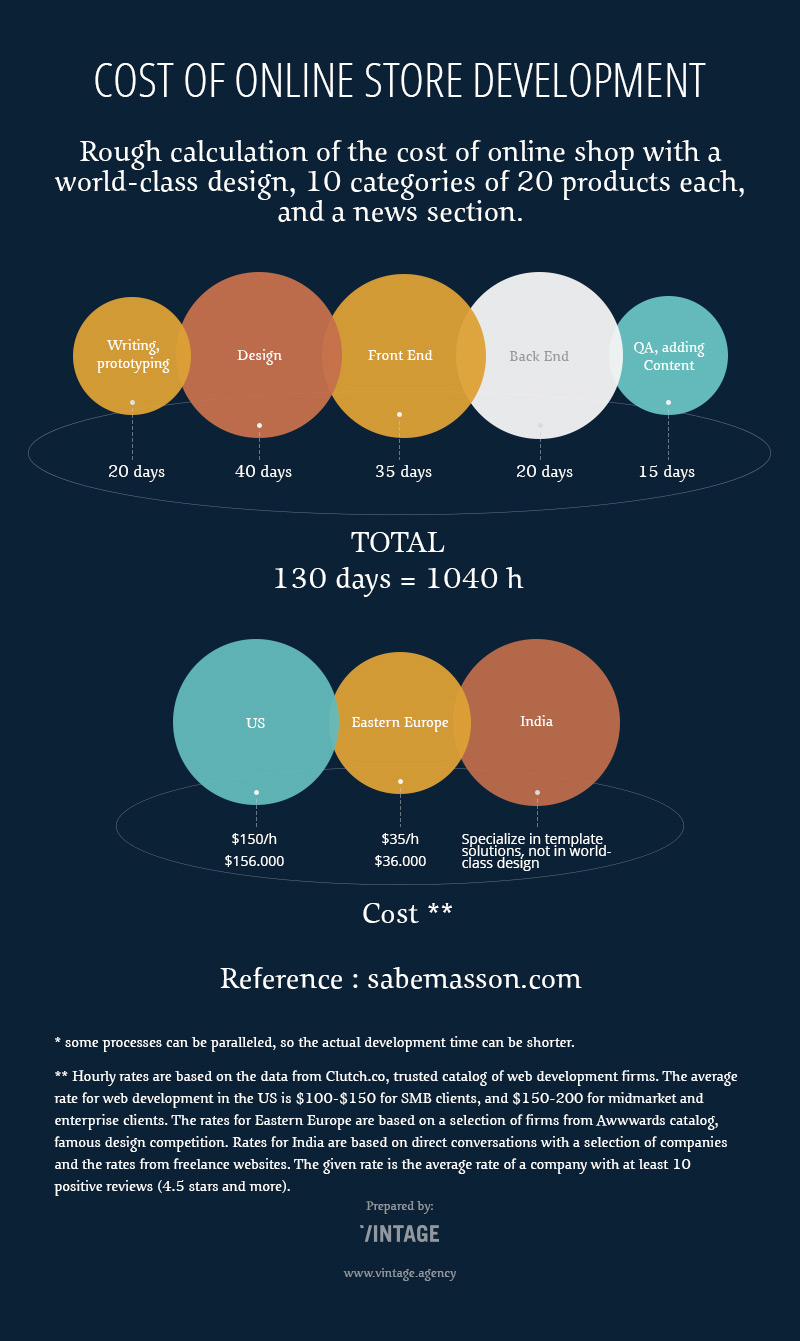
Cost of Web Service / Startup development
How do you build a website like facebook? What’s the cost to build websites like Airbnb, Olx, eBay, Youtube, Craigslist, Quora, Amazon?
There’s no simple answer for this one, as referring to popular web services, we can be talking about a wide range of things. So instead of referencing multi-billion dollar companies, compose a list of the features you need. For example, someone may need the following: personal profiles, walls, newsfeeds, likes/comments, option to add and remove friends. If you do it this way, you will make the estimate process a lot faster and simpler.
If you want to build a successful startup, then your idea needs to be original and just can’t rely on a site to do all the work. The big guys have billions of users, significant brand value, trust, and corporate knowledge distilled by years of experiments and expertise.
However, for those curious, let’s try to calculate the cost of building a simple website like Airbnb.
Here is the list of available functions.
Owners can:
- register personal profile
- fill the apartment profile with photos and text information
- indicate the available dates
- see profiles of travelers
- accept or deny travelers
- view travelers' contact information
- send personal messages to travelers
- write reviews for travelers
- withdraw cash to credit card or PayPal
Travelers can:
- register personal profile
- search apartments by region, date, number of guests, apartment type, cost, available amenities, and other options
- browse search results
- view apartment profiles with photos, prices, user reviews, information on amenities
- book apartments and cancel bookings
- browse and leave reviews
- pay with credit cards
- send personal messages to owners
Administrators can:
- view any information except personal messages
- restrict and unrestrict any profiles
Roughly, website prototyping will take 8 weeks, design - up to 12 weeks, front end development - up to 12 weeks, back end development - up to 10 weeks, content management - 1 week, QA - 1 week. Total - 44 weeks, 1760h.
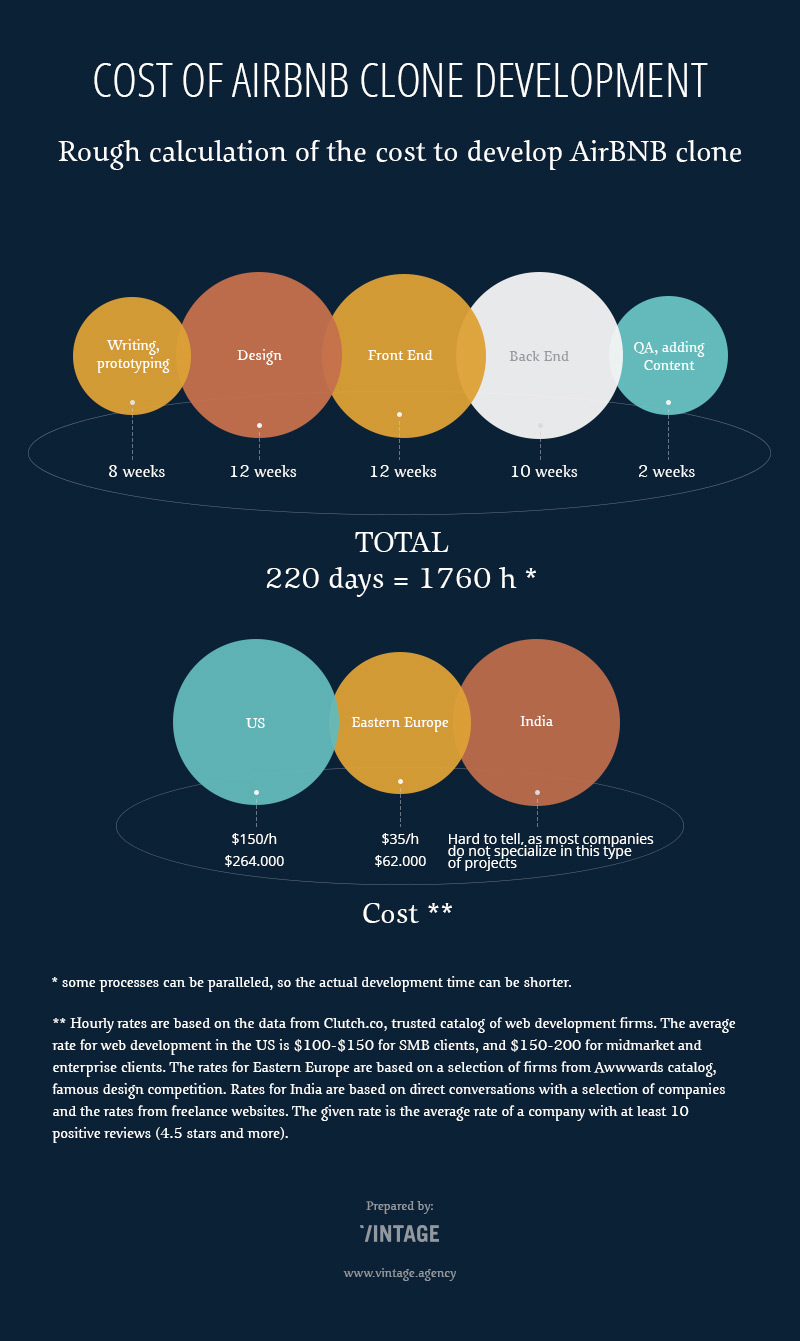
Cost to Develop a News Site or Blog
It’s never been as easy to start a newspaper or publishing site as it is today. You can just create a template-based website and start filling it with information. Though, to gain trust and credibility, you might want to build something more complex. Websites like BBC and New York Times use custom website design, tailored to their content. Such websites are quite standard in terms of functions, so their costs are relatively easy to estimate. However, if you expect a large number of visitors (more than 100K visitors a day), it is better to develop a scalable architecture, which will add to the development cost.
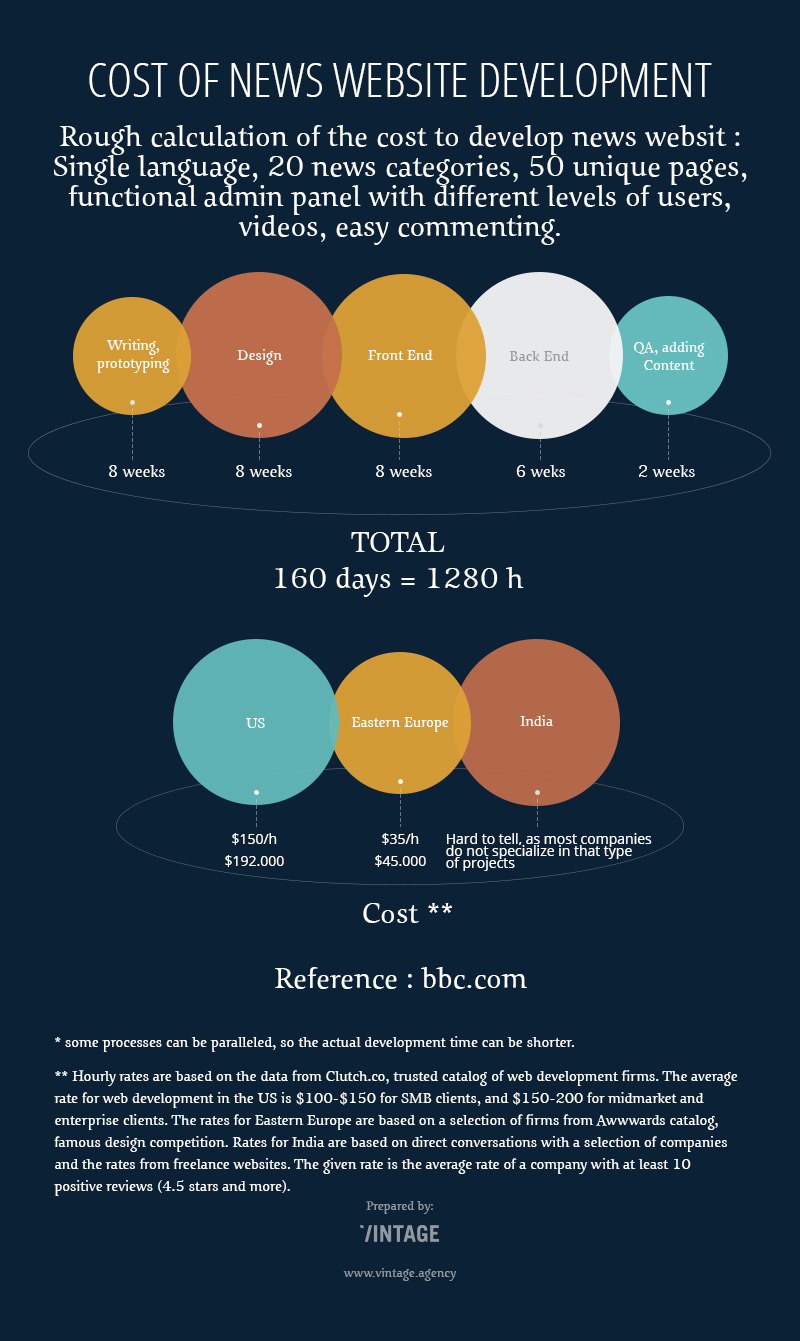
Interactive video website
Some promotional websites are based on a single or several videos you can interact with. This brings an unforgettable experience. And costs a lot. Video production will always be expensive, as well as the concept creation. If your budget is below $200K, you will probably have to look for something simpler. In any case, you may want to reach out directly to top digital agencies to find out their prices.
Additional costs of web development
There is a number of things that have a huge impact on the project cost.
Animation Animations make websites look alive and evoke emotions, which is really important when it comes to winning customers’ hearts. Good examples of animated websites include Sergey Mahno, Aiia and Fcinq. Though animations can take weeks of design and front-end development, increasing the project budget accordingly.
Production Clients often tend to omit the production costs, taking them for granted, but it is often the most expensive part of the website. If you need custom photos for your products then you have to include that in your budget. Video production and motion design are even more expensive, same goes for 3D modeling, which is necessary to produce animations on Apple’s level. Unfortunately, the detailed analysis of production costs is far beyond this article’s focus.
Changes No web project can be done without making corrections. However, every interruption and change increase the scope of the work, and your developer may require additional compensation. So there are two take-outs: think of the project’s details before starting the design and development stages and gather as much design references as you can, so you won’t have to make many adjustments afterward. The second takeaway is that it is always a good idea to add +20% reserve to your budget for changes.
Integrations If you have any 3rd-party database, software or APIs (like Facebook Graph API) that you want to integrate with your new website, this will be another significant part of the project budget. The cost depends on the complexity of integration and on how well documented is the API.
Creative complexity
All web projects require a certain level of creativity, including the creation of new logos, finding the best location for elements, and coming up with fresh designs. Some projects require a much deeper level of creativity, especially if you want to go viral and create an unforgettable experience. If you take a look at promo sites, they are all different. On some of them, a guy climbs 300 ft. high monument to test the quality of mobile connections, take a photo, and throw the phone down while it is uploading the image to Facebook. Another one lets you feel the experience of driving the elegant and powerful Fiat 124 Spider. And my favorite one shows armageddon on your street.
There are not many people who can think of an interesting and engaging concept or a story, which, at the same time, can be implemented using available technologies. It requires out-of-the-box thinking, knowledge of modern Front End technologies, video and image production, and user psychology.
Generally speaking, you may expect that the cost of a good concept will range from $10K in Eastern Europe to $150K in the US or the UK.
What Impacts the Hourly Rate
Although the general rule of thumb is “the higher the rate, the higher the quality,” you can overcome costs by outsourcing your projects to other regions, who have cheaper prices and a decent quality of work. There are a number of factors that impact the project rate, and you need to understand them to choose the right proposal for your business.
Desired level of expertise
If you just want a design vendor that implements your directions, it probably won’t cost you too much. However, if you want the agency to contribute their expertise, conduct research, and propose solutions, it will cost you a bit more, though will pay out in the long run.
Labor cost in the given region
The easy factor. Website design prices are different for every region. The poorer the country, the cheaper the workforce. The only drawback is a different mentality that can lead to a lower quality of work. To check that, just look at the company’s previous works.
Size of the company
More complex projects need bigger studios to develop them. The explanation is simple: only a big company can afford to hire niche specialists, like UX testers, web strategists, marketing researchers, icon designers, etc. Usually, big companies are more expensive, as every project involves the work of more specialists. Though if you want just to design a web page or two, a big company is not the best choice.
Brand (trust) level of the agency
There’s less at risk if you hire a well established and trusted web development companies with good client relations. In the world of business, security is something you will always pay top dollar for. In this case, an agency’s strong brand is a promise that your project won’t go wrong. This is that cheaper agencies lack and the reason of why it is more expensive to work with established agencies with a good history.
Current workload
One recommended selecting a restaurant in an unfamiliar city by the number of visitors inside. If there are no available seats, probably, the restaurant is quite good. The same rule can be applied to website design price. The more is the workload of an agency, the higher is the cost. At Vintage, we are often fully booked for 2 months ahead, though the new clients rarely complain.
The World’s Go-to Outsourcing Regions

As I have mentioned, I have considerable headhunting expertise and can describe “the average” company for any given region. However, I met a wide range of developers that are great at their jobs, regardless of where they are from. It all depends on personalities, so enjoy reading the classification but remember that it is somewhat generalized.
US - Flexible, fast, and super expensive. Work by time & material
India - Good for templates and simple websites, poor level of design, often require too much babysitting. Super cheap
Southern America - Nice people to work with, better sense of design, close timezone
Europe - Similar to Americans, world’s best web designers (especially Northern Europe), a bit slow. Super expensive
Eastern Europe - Good sense of design, good quality as for the mid-price segment, no babysitting. Though they tend to dig their heels into the ground, are not very flexible
Pitfalls of the Estimate Process
There are some pitfalls that you might fall into when trying to estimate a web project.
Misunderstanding of requirements. To avoid it, assume that obvious things are not obvious and when in doubt it is always best to “over-communicate”.
Changing requirements. If you work by a fixed-price model, you have a fixed number of design reviews and a budget to add or modify features. If you go over that small limit, your developer will request additional payments. If you want flexibility, work by time and material.
An agency’s misestimation. Everyone makes mistakes. You may ease the agency’s work by providing a detailed RFP.
What's next?
Now you are all set and armed with the necessary knowledge to start your web project. Website design pricing should now be a lot easier.
Your next steps will be to:
- Define the right teams to contact
- Compose and send out an RFP
- Select the best vendor and start the work
Vintage is one of the most awarded web agencies in Eastern Europe, and we would love to apply our expertise to reach your business goals. Consider sending over your RFP to us and we’ll be happy to help. Check out some of our work here.

View Comments